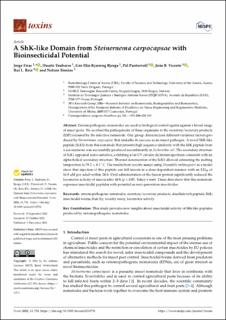| dc.contributor.author | Frias, Jorge | |
| dc.contributor.author | Toubarro, Duarte | |
| dc.contributor.author | Bjerga, Gro Elin Kjæreng | |
| dc.contributor.author | Puntervoll, Pål | |
| dc.contributor.author | Vicente, João B. | |
| dc.contributor.author | Reis, Rui L. | |
| dc.contributor.author | Simões, Nelson | |
| dc.date.accessioned | 2023-07-03T07:02:51Z | |
| dc.date.available | 2023-07-03T07:02:51Z | |
| dc.date.created | 2022-11-30T14:07:59Z | |
| dc.date.issued | 2022 | |
| dc.identifier.citation | Toxins. 2022, 14 (11), 1-22. | en_US |
| dc.identifier.issn | 2072-6651 | |
| dc.identifier.uri | https://hdl.handle.net/11250/3075273 | |
| dc.description.abstract | Entomopathogenic nematodes are used as biological control agents against a broad range of insect pests. We ascribed the pathogenicity of these organisms to the excretory/secretory products (ESP) released by the infective nematode. Our group characterized different virulence factors produced by Steinernema carpocapsae that underlie its success as an insect pathogen. A novel ShK-like peptide (ScK1) from this nematode that presents high sequence similarity with the ShK peptide from a sea anemone was successfully produced recombinantly in Escherichia coli. The secondary structure of ScK1 appeared redox-sensitive, exhibiting a far-UV circular dichroism spectrum consistent with an alpha-helical secondary structure. Thermal denaturation of the ScK1 allowed estimating the melting temperature to 59.2 ± 0.1 °C. The results from toxicity assays using Drosophila melanogaster as a model show that injection of this peptide can kill insects in a dose-dependent manner with an LD50 of 16.9 µM per adult within 24 h. Oral administration of the fusion protein significantly reduced the locomotor activity of insects after 48 h (p < 0.05, Tukey’s test). These data show that this nematode expresses insecticidal peptides with potential as next-generation insecticides. | en_US |
| dc.language.iso | eng | en_US |
| dc.rights | Navngivelse 4.0 Internasjonal | * |
| dc.rights.uri | http://creativecommons.org/licenses/by/4.0/deed.no | * |
| dc.subject | Nematoder | en_US |
| dc.subject | Nematodes | en_US |
| dc.title | A ShK-like Domain from Steinernema carpocapsae with Bioinsecticidal Potential | en_US |
| dc.title.alternative | A ShK-like Domain from Steinernema carpocapsae with Bioinsecticidal Potential | en_US |
| dc.type | Peer reviewed | en_US |
| dc.type | Journal article | en_US |
| dc.rights.holder | © 2022 by the authors | en_US |
| dc.description.version | publishedVersion | en_US |
| cristin.ispublished | true | |
| cristin.fulltext | original | |
| cristin.qualitycode | 1 | |
| dc.identifier.doi | 10.3390/toxins14110754 | |
| dc.identifier.cristin | 2085830 | |
| dc.source.journal | Toxins | en_US |
| dc.source.volume | 14 | en_US |
| dc.source.issue | 11 | en_US |
| dc.source.pagenumber | 1-22 | en_US |
| dc.relation.project | Norges forskningsråd: 221568 | en_US |
| dc.relation.project | European Regional Development Fund: ACORES-01-0145-FEDER000113 | en_US |
| dc.subject.nsi | VDP::Matematikk og naturvitenskap: 400 | en_US |
| dc.subject.nsi | VDP::Mathematics and natural scienses: 400 | en_US |

